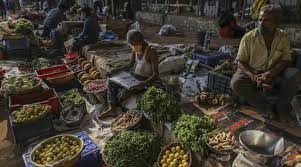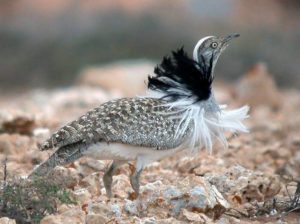Today Current Affairs: 13th January 2021 for UPSC IAS exams, State PSC exams, SSC CGL, State SSC, RRB, Railways, Banking Exam & IBPS, etc
Table of Contents
Contents:
- Ground for Contempt
- Five Years of Pradhan Mantri Fasal Bima Yojana
- Urban Local Bodies (ULB)
- Data on Retail Inflation and Factory Output
- National Youth Day
- Asian Houbara Bustard:
- Other important current affairs
1.Ground for Contempt:

The Karnataka High Court has issued notice to the Union government on a PIL petition, challenging the constitutional validity of a provision of the Contempt of Courts Act, 1971, that makes “scandalising or tends to scandalising courts” as a ground for contempt.
- Public Interest Litigation (PIL) stands for a legal action taken by a public-spirited person in order to protect the public interest (any act for the benefit of the public).
Grounds for Contempt:
- Contempt is the power of the court to protect its own majesty and respect.
- The power is regulated but not restricted in the Contempt of Courts Act, 1971.
- The expression ‘contempt of court’ has not been defined by the Constitution.
- However, Article 129 of the Constitution conferred on the Supreme Court the power to punish contempt of itself.
- Article 215 conferred a corresponding power on the High Courts.
- The Contempt of Courts Act, 1971 defines both civil and criminal contempt.
- Civil contempt [Section 2(b)] refers to willful disobedience to any judgment of the court.
- Criminal contempt can be invoked if an act:
- Tends to scandalize or lower the authority of the court [Section 2 (c)(i)]; or
- Tends to interfere with the due course of any judicial proceeding [Section 2 (c)(ii)]; or
- Obstruct the administration of justice [Section 2 (c)(iii)].
- Section 5 of the Act provides that “fair criticism” or “fair comment” on the merits of a finally decided case would not amount to contempt.
- But the determination of what is “fair” is left to the interpretation of judges.
- The Act was amended in 2006 to include the defence of truth under Section 13 of the original legislation. Implying that the court must permit justification by truth as a valid defence if it is satisfied that it is in the public interest.
Arguments of the Petitioners:
- Section 2(c)(i) of the Act violates the right to free speech and expression guaranteed under Article 19(1)(a) and does not amount to a reasonable restriction under Article 19(2).
- Though the petitioners have not challenged the constitutional validity of Section 2(c) (ii) and Section 2(c)(iii) of the Act, they have contended that rules and guidelines must be framed defining the process that superior courts must employ while taking criminal contempt action, keeping in mind principles of natural justice and fairness.
- In the contempt jurisdiction, the petitioners have contended, the judges may often be seen to be acting in their own cause, thus violating the principles of natural justice and adversely affecting the public confidence they seek to preserve through the proceeding.
2.Five Years of Pradhan Mantri Fasal Bima Yojana:

The flagship crop insurance scheme of the Government of India – the Pradhan Mantri Fasal Bima Yojana (PMFBY) – has completed five years of its launch.
- PMFBY was launched on 13th January 2016.
- The scheme was conceived as a milestone initiative to provide a comprehensive risk solution at the lowest uniform premium across the country for farmers.
Pradhan Mantri Fasal Bima Yojana (PMFBY):
- It provides a comprehensive insurance cover against the failure of the crop thus helping in stabilising the income of the farmers.
- Scope: All food & oilseed crops and annual commercial/horticultural crops for which past yield data is available.
- Premium: The prescribed premium is 2% to be paid by farmers for all Kharif crops and 1.5% for all rabi crops. In the case of annual commercial and horticultural crops, the premium is 5%.
- Premium cost over and above the farmer share was equally subsidized by States and GoI.
- However, GoI shared 90% of the premium subsidy for North Eastern States to promote the uptake in the region.
- The scheme was compulsory for loanee farmers availing Crop Loan/Kisan Credit Card (KCC) account for notified crops and voluntary for others.
PMFBY 2.0:
- In order to ensure more efficient and effective implementation of the scheme, the central government had revamped PMFBY in the 2020 Kharif season.
- This overhauled PMFBY is often called PMFBY 2.0, it has the following features:
- Completely Voluntary: Enrolment 100% voluntary for all farmers from 2020 Kharif.
- Limit to Central Subsidy: The Cabinet has decided to cap the Centre’s premium subsidy under the scheme for premium rates up to 30% for unirrigated areas/crops and 25% for irrigated areas/crops.
- More Flexibility to States: The government has given the flexibility to states/UTs to implement PMFBY and given them the option to select any number of additional risk covers/features.
- Investing in ICE Activities: Insurance companies have to now spend 0.5% of the total premium collected on information, education and communication (IEC) activities.
3.Urban Local Bodies (ULB):

Manipur has become the 4th State in the country to successfully undertake “Urban Local Bodies (ULB)” reforms stipulated by the Department of Expenditure, Ministry of Finance in its letter to the States dated 17th May 2020.
- Thus, the State has become eligible to mobilise additional financial resources of Rs.75 crore through Open Market Borrowings.
- Manipur has now joined the three other States namely, Andhra Pradesh, Madhya Pradesh and Telangana, who have completed this reform.
- Reforms in the Urban Local Bodies and the urban utilities reforms are aimed at financial strenghtening of ULBs in the States and to enable them to provide better public health and sanitation services.
- Economically rejuvenated ULBs will also be able to create good civic infrastructure.
- The reforms stipulated by the Department of Expenditure to achieve these objectives are:
- The State will notify (a) floor rates of property tax in ULBs which are in consonance with the prevailing circle rates (i.e. guideline rates for property transactions) and
- (b) floor rates of user charges in respect of the provision of water supply, drainage, and sewerage which reflect current costs/ past inflation.
- The State will put in place a system of periodic increases in floor rates of property tax/ user charges in line with price increases.
4.Data on Retail Inflation and Factory Output:

Separate data on retail inflation and factory output have been recently released by the Ministry of Statistics & Programme Implementation (MoSPI).
Retail Inflation:
- Measured by the Consumer Price Index (CPI), eased to 4.59% in the month of December 2020.
- The retail inflation for the month of November was 6.93%.
- The December CPI data has come within the Reserve Bank of India’s (RBI) upper margin of 6%.
- The government has mandated the central bank to keep retail inflation within the range of 4% with a margin of 2% on either side as per its inflation targeting.
- CPI inflation has been above RBI’s upper bound inflation target of 4 +/-2% for more than 11 months.
- RBI primarily factors in retail inflation while making its bi-monthly monetary policy.
- In its bi-monthly monetary policy meeting in December 2020, the Indian central bank had kept its key interest rates unchanged (repo and reverse repo rates) and decided to maintain an ‘accommodative stance’ as long as necessary at least through the current financial year.
Causes of decline:
- The decline in food prices: Inflation in the food basket eased to 3.41% in the month of December, down from 9.50% in November.
- Factory Output:
- India’s factory output, which is measured in terms of Index of Industrial Production (IIP), witnessed a contraction of -1.9% during the month of November 2020.
- The industrial growth so far in the fiscal year 2020-21 (April-November) has contracted -15.5%, compared to a 0.3% rise in the corresponding period in 2019.
Causes of Contraction:
- Mining and Manufacturing sectors.
- The mining sector saw a decline of -7.3% in November, while the manufacturing sector witnessed a fall of -1.7%.
- However, the electricity sector grew 3.5%.
- In November 2019, the manufacturing sector had witnessed a growth of 3.0%.
- During the same period, the mining sector had risen 1.9%, while the electricity sector had witnessed a fall of -5.0%.
6.National Youth Day:

National Youth Day is held every year on 12th January to observe the birth anniversary of Swami Vivekananda.
- The day is also referred to as Swami Vivekanand Jayanti and was designated as the National Youth Day in 1984.
24th National Youth Festival:
- Celebrated to commemorate the birth anniversary of Swami Vivekananda, the National Youth Festival is an annual gathering of youth with various activities including competitive ones.
- Theme of 2021 Festival: ‘YUVAAH – Utsah Naye Bharat Ka”.
- It will be celebrated from 12th to 16th January
- It is organized by the Ministry of Youth Affairs and Sports, Government of India in collaboration with one of the State Governments.
- As part of the National Youth Festival, the National Youth Parliament Festival (NYPF) has also been organized since 2019.
National Youth Parliament Festival:
Objective:
- To hear the voice of youth in this age bracket of 18-25 who are allowed to vote but cannot contest in elections.
- To encourage the youth to engage with public issues, understand the common man’s point of view, form their opinion and express these in an articulate manner.
- Organized by: National Service Scheme (NSS) and Nehru Yuva Kendra Sangathan (NYKS) under the aegis of Ministry of Youth Affairs and Sports.
- The first festival of the NYPF was organised from 12th January to 27th February, 2019, with the theme “Be the Voice of New India and Find solutions and Contribute to Policy”.
- This is the second NYPF festival started in December 2020.
Swami Vivekananda (1863-1902):
- He was born as Narendranath Datta on 12th January 1863.
- Introduced the world to the Indian philosophies of Vedanta and Yoga.
- He was the chief disciple of the 19th-century mystic Ramakrishna Paramhansa.
- Laid the greatest emphasis on education for the regeneration of our motherland.
- He advocated a man-making character-building education.
- Established the Ramakrishna Mission in 1897.
- It is an organization which works in the area of value-based education, culture, health, women’s empowerment, youth and tribal welfare and relief and rehabilitation.
- He died at Belur Math in 1902. Belur Math, located in West Bengal, is the headquarters of Ramakrishna Math & Ramakrishna Mission.
7.Asian Houbara Bustard:

The Pakistan government has issued special permits to Dubai royal family members, allowing them to hunt the internationally protected bird houbara bustard during the 2020-21 hunting season.
- Bustards are large, terrestrial birds that belong to several species, including some of the largest flying birds.
- Two Distinct Species of Houbara Bustard: The International Union for Conservation of Nature (IUCN) recognises two distinct species found in:
- North Africa (Chlamydotis undulata) and
- Asia (Chlamydotis macqueenii).
- Habitat of Asian Houbara:
- The population of the Asian houbara bustards extends from northeast Asia, across central Asia, the Middle East, and the Arabian Peninsula to reach the Sinai desert (Egypt).
- After breeding in the spring, the Asian bustards migrate south to spend the winter in Pakistan, the Arabian Peninsula and nearby Southwest Asia.
- Reasons for Decline: Poaching, unregulated hunting, along with degradation of its natural habitat.
- Conservation Status:
- IUCN Status- Vulnerable
- Convention on International Trade in Endangered Species of Wild Fauna and Flora (CITES)- Appendix I
- Convention on the Conservation of Migratory Species of Wild Animals (CMS)- Appendix II
Other important current affairs:
1.Public and Private Health Facilities were felicitated with the Kayakalp award for high standards of Sanitation and Hygiene.
- The government had launched a National Initiative ‘Kayakalp’ on 15th May 2015 to ensure hygiene, sanitation and cleanliness in Public Health Facilities in India.
- The scheme, which saw the participation of 716 District Hospitals and central government institutions in its first year has spread to 26 thousand 172 public health facilities now.
- Health Ministry had collaborated with Ministry of Drinking Water and Sanitation and launched Swachh Swasth Sarvatra programme, under which, one community health centre (CHCs) situated within ODF block receives one-time grant of 10 lakh rupees for undertaking improvement activities, so that the CHC becomes Kayakalp CHC.
2.Zanskar Winter Sports & Youth Festival 2021 is being organized from 18th to 30th January 2021 by the Dept. of Sports & Youth Services under the Khelo India banner in collaboration with the Ladakh Tourism Department.
- Zanskar, Zahar (locally) or Zangskar is also known as Janskar or Jangskar.
- It is a subdistrict or tehsil of the Kargil district, in the union territory of Ladakh.
- The administrative centre is Padum.
- The Zanskar Range is a mountain range in the union territory of Ladakh that separates Zanskar from Ladakh.
- Geologically, the Zanskar Range is part of the Tethys Himalaya, an approximately 100-km-wide synclinorium formed by strongly folded and imbricated, weakly metamorphosed sedimentary series.
- The average height of the Zanskar Range is about 6,000 m. Its eastern part is known as Rupshu.
3.Atal Innovation Mission, NITI Aayog launched its new edition of Atal Tinkering Lab handbook which reinforces detailed establishment and operational processes of the Atal Tinkering Labs and its journey towards an innovative ‘Aatmanirbhar Bharat’.
- The handbook named ‘The Atal Tinkering Lab Handbook 2.0’ outlines a practical guidance on structural, selection, establishment and celebration aspects of the AIM’s flagship ATL programme.
- The ATL Handbook encompasses work done by the AIM team in a framework using 4 key pillars of the ATL initiative – Selection, Establishment, Enablement, and Celebration.
- An Atal Tinkering Lab provides a makerspace where young minds can give shape to their ideas through hands on do-it-yourself mode; and learn innovation skills.
- To foster entrepreneurship and innovation, Atal Innovation Mission, NITI Aayog has established over 7000 ATLs across the country so far enabling over 3 Million+ students between Grade VI to Grade XII acquire a problem solving, tinkering and innovative mindset.
4.Shijiazhuang has become China’s new hotspot of Coronavirus surge.
- Shijiazhuang formerly known as Shimen and romanized as Shihkiachwang, is the capital and largest city of North China’s Hebei Province.
- Shijiazhuang is situated east of the Taihang Mountains.
- The city stands at the edge of the North China Plain, which rises to the Taihang Mountains to the west of the city, and lies south of the Hutuo River.
5.The two-week long forest fire in Dzukou valley on Nagaland-Manipur border has been doused.
- The 90-sq km green valley has been prone to forest fires for decades – in 2015, 2012, 2010 and 2006.
- The Dzukou Valley, popularly known as the ‘valley of flower’, is located at the border of Nagaland and Manipur.
- Situated at an altitude of 2,438 metres behind the Japfu mountain range, it is one of the most popular trekking spots in the North East.
- Dzukou valley and Japfu peak are located adjacent to the Pulie Badze Wildlife Sanctuary (Nagaland).
- There are no human habitations within the forests, but they are home to rare and ‘vulnerable’ (as per the IUCN Red List) birds – Blyth’s Tragopan (Nagaland’s state bird), the Rufous-necked Hornbill and the Dark-rumped Swift, among many others.
- Also found in the forests are endangered Western Hoolock Gibbons.
- It is covered with bamboo and other grass species.
- The valley harbours many species of flowering plants including the endemic Dzukou Lily- Lilium chitrangada.
- The valley is a source of conflict for ownership between local tribes and the state governments of Manipur/Nagaland.
- It is home to the Angami people.
7.India has expressed serious concern over the security situation in the Sahel and Lake Chad region in West Africa.
- India also condemned terrorist attacks by Boko Haram in Nigeria and Lake Chad region and by Islamic State in West Africa.
- Lake Chad is a historically large, shallow, endorheic lake in central Africa, which has varied in size over the centuries.
- The freshwater lake is located in the Sahelian zone of West-central Africa. Lake Chad is mainly in the far west of Chad, bordering on northeastern Nigeria.
- Lake Chad provides water to more than 30 million people living in the four countries surrounding it (Chad, Cameroon, Niger, and Nigeria) on the central part of the Sahel.
- It is the largest lake in the Chad Basin.
- The Chari River, fed by its tributary the Logone, provides over 90% of the lake’s water, with a small amount coming from the Yobe River in Nigeria/Niger.
- Despite high levels of evaporation, the lake is freshwater.
8.The Supreme Court has put a stay on the implementation of the three farm laws :
- The Supreme Court has put a stay on the implementation of the three farm laws until further orders.
- It has also set up a committee of agricultural experts to facilitate talks between the Centre and farmers’ unions to resolve the impasse.
- The members include
- Bhupinder Singh Mann, the national president of the Bhartiya Kisan Union and All India Kisan Coordination Committee;
- Dr. Parmod Kumar Joshi, an agricultural economist who is also the Director for South Asia, International Food Policy Research Institute;
- Ashok Gulati, agricultural economist and former chairman of the Commission for Agricultural Costs and Prices;
- Anil Ghanwat, the chief of Shetkari Sanghatana, who in articles written in the media have expressed views in favour of the farm laws.
- The Chief Justice said that the committee will not pass an order or punish and submit a report to the Supreme Court. He said the committee is the judicial process in this case.




